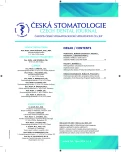Evaluation of the Preventive Program Healthy Smile
Authors:
R. Koberová Ivančaková 1; E. Ryšlavá 2; K. Prouzová 1
Authors‘ workplace:
Stomatologická klinika LF UK a FN, Hradec Králové
1; Colgate-Palmolive Česká republika, Scientific affairs manager CZ/SK
2
Published in:
Česká stomatologie / Praktické zubní lékařství, ročník 114, 2014, 5, s. 93-98
Category:
Original Article – Statistical Study
Věnováno prof. MUDr. Janu Kilianovi, DrSc., k životnímu jubileu
Overview
Introduction and Aim:
Dental caries is the most common chronic disease in the population affecting 60–90% of school children and almost all adults. Community preventive programs are one of choice how to improve oral health in school children. Preventive program Healthy Smile has started in the city of Hradec Kralove in 2000. The program comprised of theoretical part including caries prevention education and of practical part consisting in tooth brushing instruction and topical application of fluoride gel (Elmex gel, GABA, SRN) twice a year under the supervision of dental hygienist.
Methods:
In the first period of the study (after four years of realization) 150 children have been examined in three elementary schools in Hradec Kralove, one school (A) with the running program Healthy Smile, the second school( B) with the running program Healthy Teeth and the third school (C) with no preventive program (control group). In the second period of the study (after eight years) 81 school children have been examined in the identical schools. Evaluated parameters were: % of caries free, treated and carious dentition, DMFT and RI.
Results:
The data have been statistically analysed using the Student t-test and Fisher test, the level of statistical significance was p < 0.05. Children from Healthy Smile group had significantly lower value of DMFT (1.10) after four years compared to children from Healthy Teeth group (1.88) and control group (1.86) and significantly higher percentage of intact mixed dentition (34.9%) compared to control. The similar trend has been revealed after 8 years of realization. The lower value of DMFT (2.26) has been found in children in Healthy Smile group, comparing to Healthy Teeth group (3.76) and control (3.03) and intact permanent dentition was found in 48% of children in Healthy Smile group, compared to 16% in Healthy Teeth group and 22.6% in control group.
Conclusion:
Better oral health in children from the project Healthy Smile confirmed the importance of not only theoretical education in oral hygiene, but also practical training of tooth brushing together with topical application of fluorides.
Keywords:
dental caries – school children – preventive program
Sources
1. Angelillo, I. F., Anfosso, R., Nobile, C. G., et al.: Prevalence of dental caries in schoolchildren in Italy. Eur. J. Epidemiol., roč. 14, 1998, s. 351–357.
2. Krejsa, O., Broukal, Z., Mrklas, L.: Orální zdraví u dětí ve věku 5, 12 a 15 let v České republice. Čes. Stomat., roč. 101, 2001, s. 43–50.
3. Murray, J. J., Nunn, J. H., Steele, J. G.: Prevention of oral disease. New York: Oxford University Press, 2004.
4. Petersen, P. E., Kwan, S.: Evaluation of community-based oral health promotion and oral disease prevention – WHO recommendations for improved evidence in public health practice. Community Dent. Health, roč. 21 (Suppl), 2004, s. 319–329.
5. Pieper, K., Schulte, A. G.: The decline in dental caries among 12 years old children in Germany between 1994 and 2000. Community Dent. Health, roč, 21, 2004, s. 199–206.
6. WHO Oral Health Country/Area Profile Programme, www.mah.se/capp/http://www.whocollab.od.mah.se/
7. WHO. Oral Health Surveys: Basic Methods, 4th ed. Geneva: WHO, 1997.
Labels
Maxillofacial surgery Orthodontics Dental medicineArticle was published in
Czech Dental Journal

2014 Issue 5
Most read in this issue
- Isolated orbital floor fractures
- Diabetes Mellitus and Oral Health
- Smoking and Teeth Loss
- Retrospective Study of Forty-Nine Replanted Teeth
